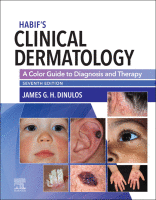Physical Address
304 North Cardinal St.
Dorchester Center, MA 02124

Skin Infections The two Gram-positive cocci Staphylococcus aureus and group A beta-hemolytic streptococci account for the majority of skin and soft tissue infections (SSTIs). S. aureus invades skin and causes impetigo, folliculitis, cellulitis, and furuncles. Elaboration of toxins by S.…

Papulosquamous diseases are a group of disorders characterized by scaly papules and plaques. These entities have little in common except the clinical characteristics of their primary lesion. A complete list of diseases characterized by scaly plaques appears in the section…

Acne Acne, a disease of the pilosebaceous unit, appears in males and females who live in westernized societies and are near puberty, and in most cases acne becomes less active as adolescence ends. The intensity and duration of activity vary…

Urticaria, also referred to as hives or wheals, is a common and distinctive cutaneous reaction pattern. Hives may occur at any age; up to 20% of the population will have at least one episode. Hives may be more common in…

The term atopy was introduced years ago to designate a group of patients who had a personal or family history of one or more of the following diseases: hay fever, asthma, very dry skin, and eczema. Atopic dermatitis (AD) is…

Contact dermatitis is an eczematous dermatitis caused by exposure to substances in the environment. Those substances act as irritants or allergens and may cause acute, subacute, or chronic eczematous inflammation. To diagnose contact dermatitis one must first recognize that an…

Eczema (eczematous inflammation) is the most common inflammatory skin disease. Although the term dermatitis is often used to refer to an eczematous eruption, the word means inflammation of the skin and is not synonymous with eczematous processes. Recognizing a rash…

Topical Therapy A wide variety of topical medications are available for treating cutaneous disease (see Formulary). Specific medications are covered in detail in the appropriate chapters, and the basic principles of topical treatment are discussed here. The skin is an…

Skin Anatomy The skin is divided into three layers: the epidermis, the dermis, and the subcutaneous tissue. The skin is thicker on the dorsal and extensor surfaces than on the ventral and flexor surfaces. Epidermis The epidermis is the outermost…